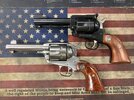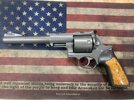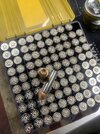fxvr5
Member
- Joined
- May 26, 2017
- Messages
- 3,270
Possible gun damage. I shot 45acp -10.5 gr BlueDot with 208 gr cast lswc, WLP, out of a S&W 645. The slide speed was high & needed the extractor adjusted to feed correctly.
The factory recoil spring got kinked.
The S&W 645 is an all steel, well built gun.View attachment 1178354
High recoil does not mean it is a 'proof load'. A proof load is defined by very high peak chamber pressure. You can get high recoil from a load that is within normal operating pressure limits, and the Blue Dot load appears to be within normal pressure limits, as it is within load data from Speer for a 200 grain bullet, and data from Lyman for their 200 and 225 grain lead bullets. It's not a proof load, but it might produce high recoil if it pushes the bullet fast enough.





